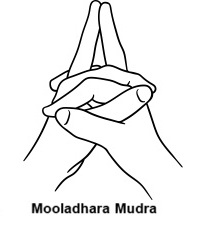Mooladhara Mudra
Introduction
Mooladhara Mudra is a yogic hand gesture associated with the Mooladhara (Root) Chakra, the first of the seven primary chakras located at the base of the spine. This chakra governs stability, grounding, survival instincts, and vital energy (prana). The mudra helps awaken, stabilize, and balance the root chakra, which is the foundation for higher spiritual practices.
Meaning
Moola = root, base, foundation
Adhara = support, basis
Mudra = gesture, seal, energy circuit
Thus, Mooladhara Mudra means “the gesture that activates and stabilizes the root support of life.” It connects practitioners with the earth element, grounding energy, promoting security, and preparing the mind-body for spiritual ascent.
How to Perform Practice
Sit in a comfortable meditative posture such as Padmasana, Sukhasana, or Vajrasana with the spine erect.
Bend the little and ring fingers of both hands inward and interlock them.
Straighten your middle fingers and join their ends so they point
upward. Bring together the tips of your index fingers and thumbs on each hand to form interlocking circles.
Close your eyes, focus on the Mooladhara Chakra (base of spine, perineum), and breathe deeply.
Optionally, chant the seed mantra “LAM” while holding the mudra to stimulate the chakra.
Benefits
Physical Benefits
Strengthens pelvic floor muscles and reproductive health.
Improves digestion, elimination, and vitality.
Supports adrenal gland function, enhancing resilience to stress.
Mental & Emotional Benefits
Promotes grounding, stability, and inner security.
Reduces fear, anxiety, and restlessness.
Enhances confidence, willpower, and self-survival instincts.
Spiritual Benefits
Activates and balances the Mooladhara Chakra.
Directs prana downward to stabilize meditation.
Prepares the base for kundalini awakening by strengthening the root foundation.
Contraindications
Should be avoided during severe constipation or pelvic pain, unless guided therapeutically.
People with lower back injury or recent pelvic/abdominal surgery should practice cautiously.
Those with excessive lethargy may experience heaviness; balance with energizing practices like Surya Mudra.
Anatomy & Physiology
Endocrine connection: Stimulates the adrenal glands and regulates survival hormones (adrenaline, cortisol).
Pelvic region: Improves circulation in the perineum, sacrum, pelvic floor, and lower digestive tract.
Respiratory system: Encourages diaphragmatic breathing, reducing stress responses.
Skeletal support: Promotes spinal alignment from sacrum upward.
Kinesiology
Interlaced fingers provide muscular engagement of the hand flexors and stabilizers.
The downward-pointing ring fingers symbolically and kinesthetically ground energy.
Engages postural awareness of the pelvic floor muscles (Mula Bandha synergy).
Balances right–left hemispheric control through bilateral hand coordination.
Neurology
Activates the sacral plexus and root nerve centers.
Strengthens parasympathetic dominance, encouraging calmness and grounded energy.
Influences survival-related neural pathways (fight-or-flight regulation).
Enhances sensorimotor awareness of the lower body and pelvic floor.
Duration of Mudra
Beginners: 5–10 minutes daily.
Intermediate: 15–20 minutes in meditation.
Advanced: Up to 30–45 minutes or during full chakra meditation sessions.
Best practiced in the morning or when feeling anxious, ungrounded, or fearful.
Counter Mudra
Apana Mudra – to support elimination and balance lower body energy.
Prithvi Mudra – to increase grounding and vitality.
Chin Mudra – to balance excess grounding with higher awareness.
Conclusion
Mooladhara Mudra is a powerful grounding gesture that awakens and balances the Root Chakra, providing stability, courage, and connection to life energy. It serves as the foundation for higher yogic practices, ensuring that spiritual growth is rooted in strength and balance. By integrating this mudra into meditation, pranayama, or chakra work, one can cultivate security, resilience, and harmony in both material and spiritual life.
FAQ
Q1: What is the best time to practice Mooladhara Mudra?
Morning meditation or times of stress and insecurity are ideal.
Q2: Can it help with anxiety?
Yes, it reduces restlessness, promotes grounding, and eases fear-based anxiety.
Q3: Is it only for spiritual awakening?
No, it also has practical benefits for digestion, vitality, and stress resilience.
Q4: Can beginners practice it?
Yes, it is safe and simple for all levels, but duration should be increased gradually.
Q5: Does it help in kundalini awakening?
Yes, it strengthens the root support needed for safe kundalini rising.
References
Swami Satyananda Saraswati – Asana, Pranayama, Mudra, Bandha (Bihar School of Yoga)
Gertrud Hirschi – Mudras: Yoga in Your Hands
Swami Niranjanananda Saraswati – Prana and Pranayama
Feurerstein, Georg – The Yoga Tradition
Bihar Yoga Publications on Chakra and Kundalini practices

